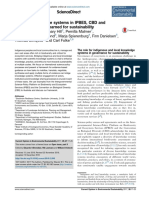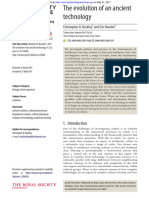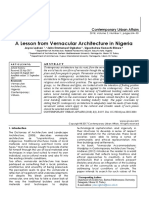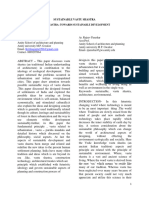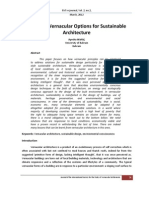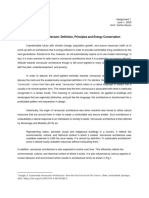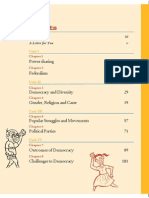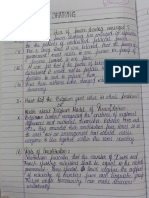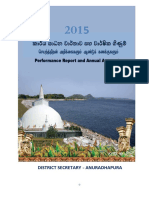RESEARCH ARTICLE
Toward sustainable development: Lessonsfrom vernacular settlements of Sri Lanka
Ranjith Dayaratne
Department of Architecture and Interior Design, University of Bahrain, PO BOX 32038, Bahrain
Received 6 May 2017; received in revised form 30 March 2018; accepted 13 April 2018
KEYWORDS
Vernacular settle-ment;Sustainable lesson;Buddhism and cul-ture;Traditional practice;Sri Lanka
Abstract
From modern urban perspectives, indigenous housing practices are regarded as undeveloped,backward, and require improvements. They may be valid for measuring on the basis of standards alien to the communities. However, these perceptions have obfuscated theappreciation and potential adoption of holistic, culturally relevant, and traditionally testedapproaches to planning and housing that have sustained communities for centuries.Sri Lankan indigenous settlements have been founded on principles and understanding acquiredthrough the wisdom of Buddhism. For the Sri Lankan indigenous, sustainability has been anintrinsic accompaniment to everyday life, unlike articulated modern discourses. However, thesetraditions exert minimal bene
ts to recent housing practices, and researchers are lookingelsewhere to develop mechanisms to infuse sustainability as a recently discovered issue of signi
cance.The present study examines the principles underlying several indigenous settlements in SriLanka through close observations supported by documented evidence and demonstrates theirvalidity and appropriateness for contemporary planning practices. This study argues thatapproaches to sustainability should be generated holistically from within rather than from theoutside and offers several propositions that can redirect the contemporary housing and planningpractices.
&
2018 Higher Education Press Limited Company. Production and hosting by Elsevier B.V. onbehalf of KeAi. This is an open access article under the CC BY-NC-ND license(http://creativecommons.org/licenses/by-nc-nd/4.0/).
1. Introduction
Traditional vernacular settlements are those formed by thepeople living and working in them by employing the wisdom,knowledge, and practices handed down from generation to
Available online at www.sciencedirect.comwww.keaipublishing.com/foar
Frontiers of Architectural Research
https://doi.org/10.1016/j.foar.2018.04.0022095-2635/
&
2018 Higher Education Press Limited Company. Production and hosting by Elsevier B.V. on behalf of KeAi. This is an open accessarticle under the CC BY-NC-ND license (http://creativecommons.org/licenses/by-nc-nd/4.0/).
E-mail address:
ranjithdayaratne@gmail.comPeer review under responsibility of Southeast University.Frontiers of Architectural Research (2018)
7
, 334
–
346

generation. They are often well-adapted to the geographi-cal terrain, the society inhabiting the land, and theirenvironmental contexts. The use of available materialsand technologies and the employment of labor from withinthe settlements invariably contribute to sustainability.These characteristics have been inherent in such settle-ments even before the modern world coined the termsustainability. However, in current discussions on sustain-ability, the emphasis is on the invention of technologies,systems, and other means, ignoring what traditional verna-cular settlements have practiced. This phenomenon is ironicbecause by ignoring the vast repository of knowledge andsystems of vernacular settlements, we are missing out onresourceful understanding that can be meaningfullyengaged in sustainable development. Vernacular settle-ments cannot be reinvented in the place of contemporarysettlements. However, the fundamentals of their practicescan help in rethinking the production and maintenance of modern settlements. Furthermore, a large part of earth'sinhabitants still live in such vernacular settlements, andlessons can be learned for new settlements and thecontinuation of the existing settlements themselves, whichseem abandoned under the in
uence of modernization.Sri Lanka, which is located south of India in the IndianOcean, is a small island of 22 million inhabitants, whoseancestors lived in such sustainable vernacular settlements.History shows that the island was rich in fauna and
ora andproduced a settlement system that sustained themselves inharmony with Nature, land, terrain and cyclical weatherpatterns. The country has been known as the
“
Granary of the East,
”
producing paddies aplenty without harming theland and the environment. In the past, its people livedprosperous lives in small peasant hamlets, achieving whatits present population appears unable to achieve.In this context, this study examines the principles under-lying the indigenous settlements in Sri Lanka throughpersonal close observations that are supported by docu-mented evidence and demonstrates their validity andappropriateness for contemporary planning practice. Thestudy aims to uncover the principles of the most meaningfulpractices. It argues that approaches to sustainability shouldbe generated holistically from within rather than from theoutside, particularly when they are abundantly available invernacular communities. This study
nally offers severalpropositions that can redirect the contemporary housingand planning practices, such that traditional knowledge andwisdom can be fruitfully re-employed.
2. Traditional vernacular settlements: areview
Many scholars have studied and theorized on vernacularsettlements. Among them, Alexander (1979), Knapp (1989),
and Oliver (1997) showed how vernacular settlements areculturally meaningful and kinder to the environment.Tulistyantovo (2010) reiterated that traditional vernacularsettlements are humane and came into being through wisdomaccumulated over centuries and have exhibited worldviews,foresights, and methods that are unavailable to the educatedmodern man. The demise of tradition as the basis of living inthe contemporary world has eradicated traces of sustainableapproaches to farming, construction, production, and con-sumption. Most indigenous communities cannot manage theirnatural resources for making even a meagre living last long.Many have also looked at the sustainability of the vernacularfrom ideas and practices, such as cultural compatibility(Rapoport, 1969), ecological design and energy ef
ciency(Foruzanmehr, 2015a), materials and technologies(Dayaratne, 2013), and even individual buildings of excep-tional qualities from around the world (Weber and Yannas,2014). However, not much has been studied in terms of holistic approaches to settlement planning (Gokman, 2002).Asquith and Vellinga (2006) and Vellinga (2013) argued that
research that explicitly demonstrates the relevance of vernacular knowledge and skills in contemporary settlementsis inadequate.The wisdom of indigenous communities in understandingthe world as a uni
ed interdependent system is clear in thenow famous speech of the Red Indian tribal leader, Seattle,in 1854.
1
“
The air is precious to the Redman, for all things sharethe same breath
—
the beast, the tree, the man. They allshare the same breath
…
For whatever happens to thebeasts soon happen to Man. All things are connected
…
Whatever befalls the earth befalls the sons of earth.Man did not weave the web if life. He is merely a strand in it. Whatever he does to the web, he does it tohimself
…
Continue to contaminate your bed, and youwill one night suffocate in your own waste.
”
Ceylon Daily News, Friday, June 15, 1979Many other native notions about interconnectedness of the natural and manmade worlds and how these can beemployed in creating healthy habitats exist within manyvernacular societies (Weber and Yannas, 2014). Unfortu-nately, the advent of modernism, industrialization, andlarge-scale housing and planning had marginalized these asprimitive, irrelevant, and incompatible with modern waysof living. Nevertheless, at the end of the 18th century,theories, such as
“
organic architecture
”
proposed by FrankLloyd Wright, attempted to rekindle similar ideas by advo-cating the integration of a building to the surroundingNature.Current interest in sustainability is concerned witharticulating ways of
“
managing economic growth,
”
suchthat the
“
quality of life
”
of future generations is ensured;however, the focus is on energy production and use.Sustainable settlement allows all its citizens to meet theirown needs and enhance their well-being without damagingthe natural world or endangering the living conditions of other people now or in the future (Girardet, 1999). Althoughprimarily linked to development and economics, environ-ment has now taken the center stage, and architects havere-oriented its emphasis toward environmental degradationand resource depletion through the building industry, inwhich architecture and planning play a central role (Steel,1997). In pursuit of this, modern developments are now
1
Scholars often contest the authenticity of this statement.However, sentiments and ideas expressed in this are reminiscentof those often held by the indigenous people; thus, ignoring thevalue of the statement is dif
cult.
335Toward sustainable development
being refocused. In the
elds of architecture and planning,several distinct approaches have become oriented towardenergy management through bio-climatic design (Yeang,1996), natural resource management, or environmentalplanning.
2.1. Indigenous communities and the modernworld
Most indigenous communities facing
“
developments
”
of themodern world have found themselves marginalized andreduced to recipients of subsidies. They are often told thatthe ideas they possess are inadequate and their methodsold-fashioned and ill-suited to the sophisticated newsociety. They are asked to
“
learn
”
anew, undergo trainingto use modern gadgetries and systems, and give up theirtraditional lifestyles. In many societies, contemporaryforces have
“
evicted
”
them from their homelands to citiesto become the dispirited working underclass living inderelict residential settings.However, some indigenous people continue to value anddefend their culture and lifestyles and have entered thedebate on sustainability by drawing from their traditions andrecreating new solutions (Knudtson and Suzuki, 1992). Nativepeople have been rediscovering their nearly lost traditions of medicine and agriculture and collectively challenging theworld while offering alternatives. For example, GregoryCajete, a Pueblo Indian professor of education in NewMexico, assembled a collection of essays about nativetraditions on health, environment, and agriculture. Hearticulated the Native American approach known as
“
theol-ogy of place
”
as a window into natural af
liation, a principlethrough which people can explore relations with plants andanimals (Cajete, 1994, 1999a, 1999b).
In 2002, the international indigenous people's summiton sustainable development in South Africa announcedwhat is now known as the Kimberly Declaration, whichdespises
“
unsustainable extraction, harvesting, produc-tion, and consumption patterns leading to climaticchange, widespread pollution, and environmentaldestruction
”
of indigenous environments. These percep-tions have begun to question the nature of moderndevelopments (Khosla, 2002). For example, Norberg-
Hodge (2000) divulged the case of Ladakh. He said,
“
asone of the last subsistence economies to survive virtuallyintact to the present day, Ladakh has been a uniquevantage point to view the whole process of develop-ment.
”
Phillips and Titiola (1995) indicated that
“
indi-genous knowledge is the largest single knowledgeresource not yet mobilized in the development enter-prise.
”
Steel (2005: 57) commented on one of the world'smost sophisticated dam constructions and argued that
“
the
rst and most shocking realizations is that the verytraditional societies of the kind displaced by the AswanDam have been the most effective in managing environ-mental resources over time, of true sustainable develop-ment.
”
He further said,
“
what distinguishes the 250million indigenous people that remain in more than 70countries in which they have managed to survive is theirapproach towards the land
”
and sustainability of theirhabitats.Research offers three reasons for considering the rele-vance of indigenous knowledge to contemporary sustain-ability (Ford and Martinez, 2000). First, traditional andecological knowledge (TEK) comprises a wealth of localobservations by people whose lives are tied to the land incomplex and intimate ways, which modern research cannotmatch. Second, TEK is holistic by nature and can clearlycomplement contemporary science, which can only studyentire system behaviors that can be extrapolated only fromknown conditions and processes. Third, excluding thewidest possible diversity of problem solving approachesfrom the novel and complex problems of the world iscounterproductive. Ford and Martinez (2000) and Nathan
(2000) argued for the incorporation of traditional indigenousknowledge into conservation and restoration planning. Astrong international movement toward the institutionaliza-tion of such knowledge exists (Mauro and Hardison, 2000).In this context, re-examining indigenous practices notonly help continue to develop them but also facilitatelearning from them for creating modern sustainable settle-ments. However, no argument supports the dichotomy of indigenous versus modern, where one is assumed betterthan the other (Bebbington, 1993).
2.2. Sustainability and vernacular settlements
Researchers understand that vernacular settlements possessan enormous wealth of knowledge of sustainable living andbuilding. However, mainstream literature appears not tohave bene
tted considerably from such knowledge. Oliver(2010), who spearheaded a movement to recognize thevalues and meanings of traditional vernacular settlements,articulated this at his keynote speech in the ISVS-5 Con-ference in Sri Lanka. 'ISVS e journal', the journal of theInternational Society for the Study of Vernacular Settle-ments, has focused on the issue and has brought to thepublic the ways through which this relationship exists. Forexample, ISVS-1 (1999) dealt with the role of local knowledgein the built environment. In its proceedings, Tjahjono (1999)observed that
“
vernacular settlement is perhaps the mostenduring type of human living
”
and argued that
“
althoughmass housing development has increasingly
lled the surfaceof the earth, vernacular settlements still endure and bringhope to many people.
”
Numerous aspects of this relationshiphave been explored from the perspectives of sustainability.These studies fall in to the following categories:(1) Those that demonstrate how vernacular buildings haveproduced human comfort by employing climaticallyresponsive buildings, technologies, techniques, anddevises without resorting to mechanical means. Theyshow how traditional buildings achieve thermally com-fortable interiors by proper orientation and use of materials and technologies (Fernandes et al., 2015;Foruzanmehr and Vellinga, 2011; Foruzanmehr, 2012a,
2012b, 2012c, 2014, 2015a, 2015b; Yadav, 2010);
(2) Those that demonstrate how vernacular settlementshave responded to the cultural aspirations of peopleand produced settlements that are culturally expressiveand wholesome (Alexander, 1977; Buyukmihci et al.,
2002; Numan and Dincyurek, 2012; Rapoport, 1969);
R. Dayaratne336
(3) Those that demonstrate how vernacular settlementsrespond to geological and environmental resources andgeographical conditions sensitively and have producedbuildings and settings that are kind and sensitive to theenvironment (Rasavi, 2008; Tokman et al., 2002; Tucker
and Gamage, 2014);(4) Those that demonstrate attitudes and approaches to lifeand everyday living, which have infused deep meaningsand symbolisms that affect sustainability and nurturing of communities (Oliver, 2010); and(5) Those that examine the technologies and techniquesadopted in vernacular settlements (Fathy, 1976) thatare sensitive to the environment and therefore contri-bute to sustainability. For example, Dayaratne (1999,2000, 2010) examined traditional mud construction tech-
niques, which have been reinvented as a modern buildingmaterial that contributes to the construction of sustain-able buildings in Sri Lanka.Many of the studies related to environmental responseshave come from the Middle East, Asia, and Africa, wherethe harsh climates have been a central issue of buildings.There, in the days of traditions, the absence of mechanicalmeans made people creative and seek simple yet effectivetechnologies to cool the interiors. Foruzanmehr (2011
–
2015a and Wahid (2012) presented techniques, such as
the wind towers in the Middle East and the Persian Gulf,which were environmentally induced built elements thatgive rise to a language of architecture in the region.Similarly, Sri Lestari (1999) discussed how the shape of tropical architecture helps produce thermal comfort with-out mechanical means. Praytino and Winaktoe (2002)offered an ecological model based on vernacular housing.Moreover, attempts have been made to reinvent similarelements by employing modern techniques (Shaffer, 2010).For example, Dayaratne (2010) presented how traditionalearth technologies have been reinvented for sustainabilityand have become a popular alternative to modern con-crete technologies in Sri Lanka.Few studies have explored the principles and practices of traditional settlements, which contribute to sustainablesettlements and how they can be utilized in contemporarysituations. One of the most recent is that of Tucker andGamage (2014), which emulates the principles derived fromtraditional settings in creating post-disaster housing. Tuckerand Gamage indicated that such approaches are likely toproduce durable and sustainable post-disaster housing.Notably, most Sri Lankan architects have adopted theprinciples of design and technologies of traditional archi-tecture, following the pioneering work of Geoffrey Bawaand Minnette De Silva. Robson (2002) claimed that duringthe period before open economy, architects, such as Bawa,returned to traditions and reinvented the essence of vernacular architecture, which many architects today haveadopted into mainstream practice. Nevertheless, more canbe learned and adopted.
3. Method of inquiry
The present study aims to examine the principles, attitudes,and values that underpin the settlement patterns andpractices of Sri Lankan vernacular settlements. It assemblesseveral propositions that are useful in the contemporarypractices of housing, building, and settlements. The methodadopted aligns closely with the method of phenomenologicalresearch, which is a qualitative approach to understanding thephenomena. Qualitative research employs a broad range of conceptual and methodological approaches for examining realsituations. It is inductive and unravels the richness andcomplexity of the issue for generating descriptive general-izations and theories based on observations and experience.Seamon (2014) indicated that
“
this approach therefore is verydifferent, conceptually and methodologically, from quantita-tive methods, which typically establish a limited number of prede
ned, deductive categories by which the complexity of human life can be reduced to standardized measures andanalyzed statistically.
”
Predetermined ideas or tools of mea-surements do not restrict the researcher from employing thisapproach. Instead, the researcher examines the issues directlyand works to
“
draw accurate descriptions, discover unnoticedinterconnections, and identify practical understandings thatmight be of human and environmental bene
t
”
(Seamon,2014).This study employs qualitative methods for constructingthis knowledge using multi-faceted inquiriesa. by examining the literature on vernacular settlements;andb. by employing the
rst-hand experience and under-standing of the researcher who has lived in suchsettlements for well over two decades before movingto the city. Some insights are dif
cult to allocate to asingle source or reference but are outcomes of
“
beingin place
”
and
“
lived experiences and observations.
”
The author lived close to a number of such villages:
nagala
in Bibile (2000
–
2002) in the Uva Privince,
“
Wedikumbura
”
in Monaragala (2008
–
2010), and
“
Buduruwagala
”
in Wellawaya (2014
–
2016) in thecentral province. (See Figure 1). During the periodof stay, the researcher immersed in village life,interviewed the residents, and jotted observations.The interviews were often held with the villageheadmen; however, listening to the narratives of thefolks also generated insightful understanding. Infer-ences were therefore generated from the livedexperiences in the villages.
Figure 1
Map of Sri Lanka and Locations of the Fieldwork.Source: Author.
337Toward sustainable development

























